Feature Creep: Definition, Consequences, And How To Avoid It
Feature creep is not the most common problem in software development. However, ignoring its possibility during development can be a disaster for even the most skilled product managers. After all, it can lead to bloated software—an issue likely to leave users dissatisfied. Regrettably, not everyone knows how to navigate around this issue.
That said, we shall delve into the essence of feature creep, its implications, and some strategies to prevent its onset. Furthermore, we will analyse real-world examples of feature creep and investigate the underlying causes contributing to its emergence.
Let’s start with a brief definition.
Table of Contents
- What is meant by feature creep?
- Are feature creep and project creep the same?
- Why is feature creep a problem?
- What is a real-life example of feature creep?
- What causes feature creep?
- How can we avoid feature creep?
- The bottom line: feature creep
- Machine Learning In Finance: 12 Essential Applications
- How To Create Interactive Compliance Training For Bank Employees
- How Fintech Apps Are Using Gamification To Increase User Engagement
- Top Gamification Companies for Employee & Customer Engagement
What is meant by feature creep?
Feature creep is when developers add excessive features to a product over time.
However, Having many product features won’t always lead to feature creep.
The keyword here is “excessive,” which often refers to including unnecessary features. As such, it typically has a negative rather than a positive connotation with its consequences.
Some people may also refer to it as feature bloat or featuritis.
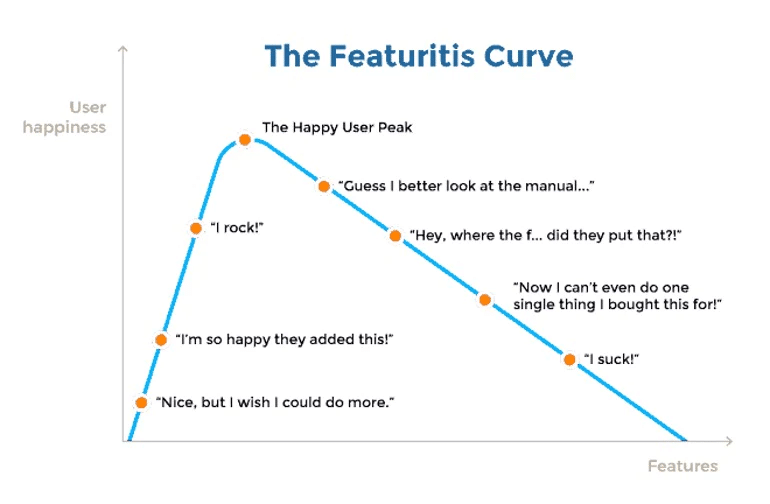
Source: Shopify
All of these refer to the same concept.
Remember, though, that there are specific terms people use interchangeably with feature creep that refer to different concepts. Scope creep is one such example of this misunderstanding.
Are feature creep and project creep the same?
Scope creep, or project scope creep, is the tendency for a project to expand beyond its original goals. It’s similar to feature creep as it also involves adding unnecessary elements to a project.
However, scope creep is more concerned with project management than product development.
Moreover, their consequences differ significantly.
When project scope creep occurs, projects become at risk of the following issues:
- Budget or cost overruns – Unexpected changes that increase the total project cost or budget.
- Schedule delays – Any delays in the continuation of a project that may lead the company or team to miss deadlines.
- Resource allocation issues – When the company cannot effectively allocate resources to different departments.
Feature creep doesn’t necessarily lead to these issues.
Instead, its consequences often revolve around creating a product that is less valuable to end-users. To further clarify, it would help to understand the implications of feature creep.
Why is feature creep a problem?
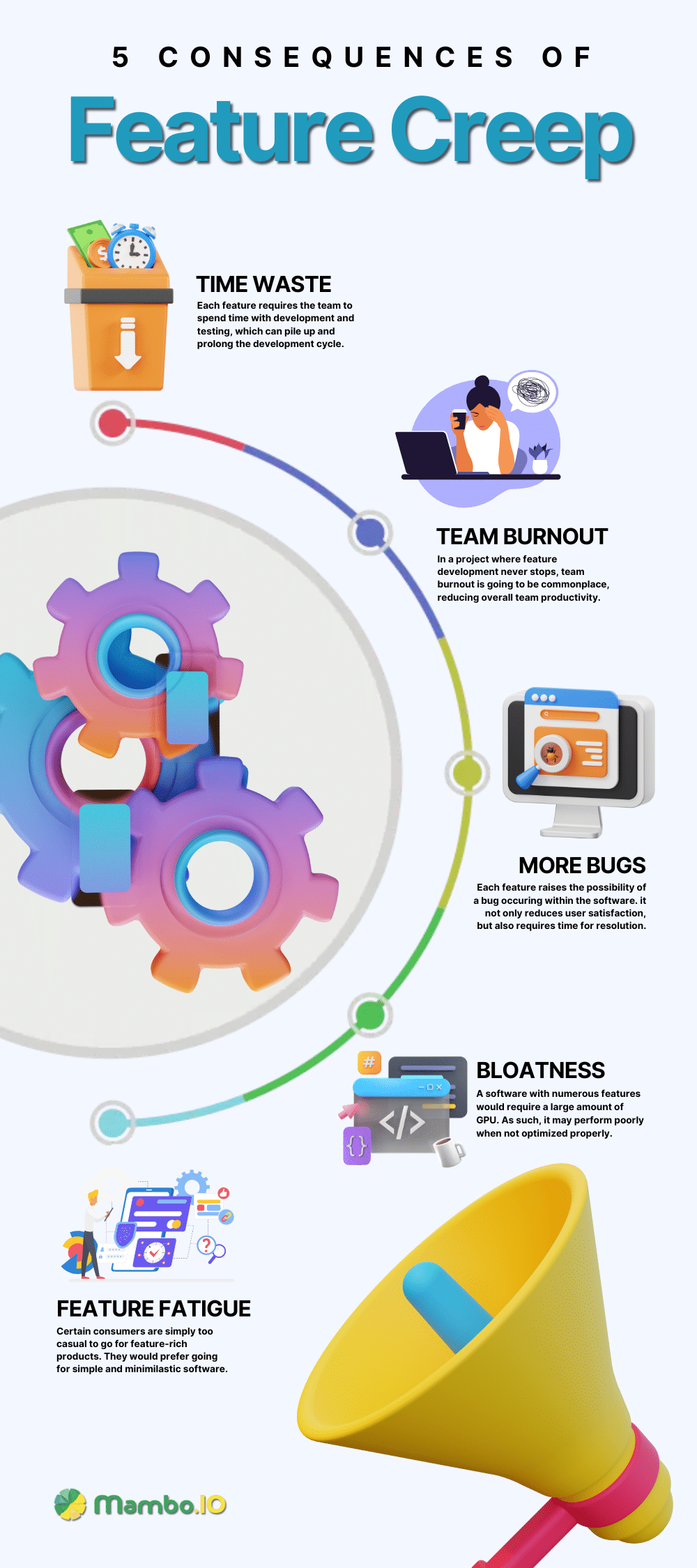
#1. Adding new features takes time
Every feature requires a specific amount of time, regardless of complexity.
Naturally, as the product manager, you’d have to allocate time for testing and development for each feature. The added time can pile up over time and prolong the development cycle.
Granted, delays are a common issue, but it does pose the possibility of missing opportunities.
For one, a similar product might come out before your launch, effectively reducing the potential market size you can obtain. It’s also possible for the demand for your product to wane before you can get it out to the market. An excellent example of this would be Google Wave.
Google Wave was a highly-anticipated platform whose concept was announced in May 2009. It generated a lot of hype, but people realised that it will probably be impractical over time.
As a result, interest in it flickered until it was abandoned entirely in 2012.
#2. Teams would be stretched too thin
It’s not uncommon for teams to find themselves stretched too thin due to excessive work.
In fact, a study by Haystack shows that 83% of software developers suffer from workplace burnout. Interestingly, a major factor (47) to this issue was attributed to heavy workloads.
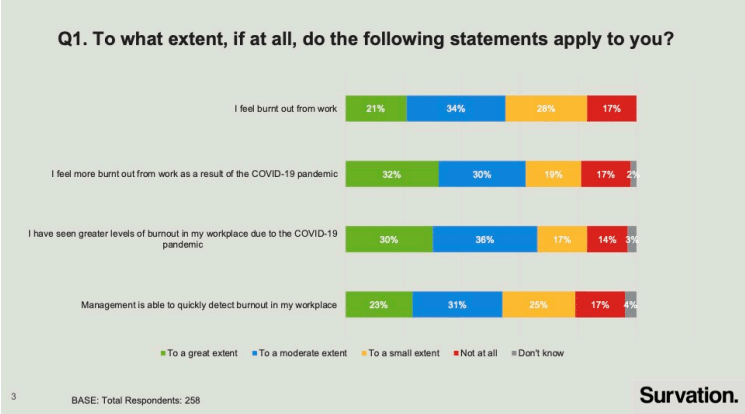
Source: Haystack
Feature creep enables this problem as it sets the stage where developers are encouraged to never stop developing. In short, the workload doesn’t stop for as long as the product exists.
It would also overburden other teams like the:
- Customer support staff – They would have to memorise every existing feature of the product to assist overwhelmed users.
- Marketing team – The team would have to create marketing campaigns every time the product gets an “upgrade” by adding new features.
- Sales team – The ever-changing product may confuse the team as they’ll never truly know the exact value proposition of what they’re selling.
#3. Too many features mean higher risks of bugs
No software is 100 percent bug-free. Each feature has the likelihood of producing a bug. Feature creep, then, whether it would result in a significantly higher likelihood for bugs.
The more bugs there initially were, the more bugs users will likely encounter, which may lower user satisfaction. Even if you manage to fix them all, it will take time to do so, extending the project deadline indefinitely. Not to mention more complex software also means they are harder to troubleshoot. As such, bugs in these programs would be more difficult to find.
#4. Feature creep leads to software bloat
In software development, it’s important to understand that not every feature would be useful. There’s a good chance one or two features you came up with will rarely be used, if ever.
A study by Pendo shows 80% of features are rarely or never used.
However, that’s not to say that 80% should be removed immediately.
There’s a chance some were made to cater to a specific subset of your target audience. And if so, they are still of value. For instance, most people may never use the reported fraud in a banking app. But if it’s needed by a client, it better be there.
Those features are user-centric and are, therefore, valuable, one way or another.
Feature creep, however, does not revolve around features made for the users. It often focuses on features made for one of the following reasons:
- Impress investors during sales pitches.
- Get an executive off the back of developers.
- Address an internal request from a team member.
- Satisfy the whims of executives.
- Mimic is a successful product regardless of its relevance.
#5 Feature creep can lead to feature fatigue
Feature fatigue may refer to different things, though admittedly, all have negative connotations.
Consider the following definitions:
- Feature fatigue relates to how consumers steer away from products with too many features. The most likely cause is their fear of not being able to use all these features.
- Feature fatigue is the tendency to associate feature-rich products with common software issues. These may include poor performance, instability, and complex UIs.
- Feature fatigue is when a consumer prefers simple products.
No matter the definition, it’s clear that feature fatigue is something you don’t want to inflict on your users. Unfortunately, this phenomenon is exactly what feature creep eventually leads to.
If the idea of feature creep isn’t threatening enough, it would help to look at some examples.
What is a real-life example of feature creep?
Smart fridges
You’ve most likely heard or seen an ad about it before.
Smart fridges were heavily marketed as the new way to store groceries. However, when asking owners about their smart fridges, they would typically have similar answers:
- It’s over the top.
- It’s no different from a regular fridge.
- It brought more inconveniences than conveniences.
- It broke down faster than regular fridges.
There is mostly negative feedback from this particular product design.
It might surprise some since smart fridges offer tens if not hundreds more features than regular fridges. But that’s precisely the point—more features don’t necessarily mean better.
Yes, you can add features closely related to the product.
Faster ice formation, better cooling, and more storage are features that users would actually like in a fridge. But introducing TV or AI as a feature will rarely entice most consumers.
Skype
It’s a mystery to many people why Skype failed and was replaced by Zoom. Though we can’t say for certain the reason behind its failure, part of it was likely due to feature creep.
It’s not the features it has, to be precise, but rather one of the consequences of feature creep. Notably, its downfall was caused by the teams being stretched too thin and too busy adding features. As a result, they didn’t have time to add valuable features.
Furthermore, they didn’t have the resources to improve the existing functionalities. As such, Skype users commonly complain about its lack of customisation, poor call quality, and unreliability.
Luke Wroblewski’s contact form scenario
Luke Wroblewski’s contact form scenario, which he talked about in Mind the Gap is another excellent example of feature creep. It is a hypothetical example, and here’s how it goes:
The UX team created a contact form, which appears as follows.
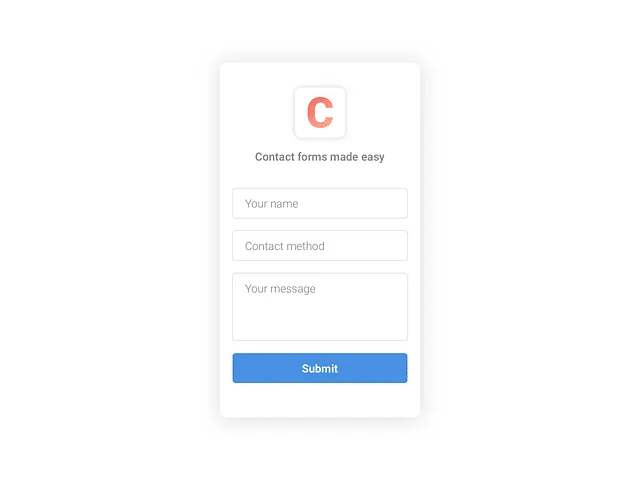
Source: Medium
As you can see, it’s pretty simple. However, upon hearing about this, the sales team decided it was an excellent opportunity to gather leads. As such, they added other fields, like phone number, address, and such. The marketing team also thought it was an opportunity to capture demographic information. As a result, they added more fields like gender and date of birth.
This went on until the resulting form became like this.
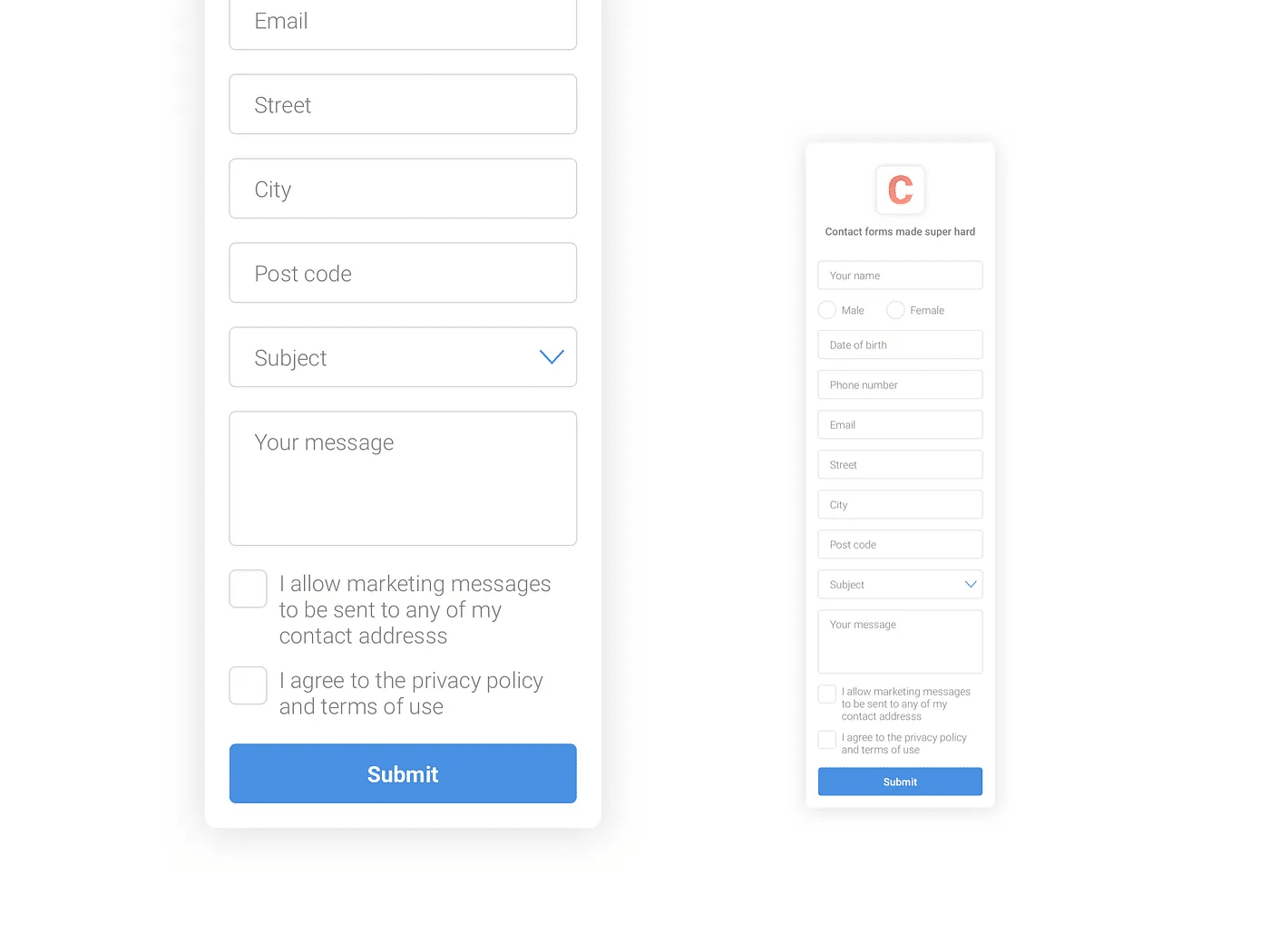
Source: Medium
As one might imagine, it’s excessively complex for mere contact form. Naturally, this would discourage users from completing the form, eventually making it pointless.
What’s worse is this was completely unintentional. All teams intended to improve the form, yet only ended up making it worthless. Such is the fate of many products, especially when handled by product managers completely unaware of this problem. That doesn’t have to be the case for you, however. Read on as we go over the common causes of feature creep.
What causes feature creep?
#1. Excessive desire to stay “relevant”
It’s common for products to become obsolete at some point.
Alas, some companies don’t understand this, and so they try too hard to make their product stay relevant. They believe taking on a completely new project would not be as fruitful.
Alas, their way of staying relevant is adding features upon features upon features.
An example of this is Internet Explorer—a once-dominant player in the web browsing landscape that eventually became obsolete. Microsoft tried to remain relevant by adding features, only to fail. It instead became infamous for its vulnerabilities and slow performance. When they did decide to take on a new project, a.k.a. Microsoft Edge, they succeeded.
#2. Desire to capture new market segments
It may also be a matter of having an excessive desire to capture new market segments. When a company wants to expand, they may add new features they think would help in that regard. While it might help somewhat, it’s at the cost of neglecting the existing audience or users.
Snapchat, for instance, was popular among the younger demographic due to its unique features like temporary photo sharing. The app was also quite simple and minimalistic.
However, they sought to attract a wider audience by adding features like Discover and Stories. It was most likely because they wanted to compete with social media outlets like Instagram. While it did increase its user base and reach, it also shifted its focus away from its original user base. It’s no longer minimalistic, which was what popularised it in the first place.

Source: Snapchat
#3. A hands-off product manager
A product manager is supposed to oversee the feature development closely.
If you’re not doing this and are instead just doing the bare minimum, many issues may arise. In particular, the development team members may not know which features are completed.
They’re also unaware of the remaining budget or time, resulting in excessive features.
#4. Overambitious promises to investors
It’s common to promise too much to investors and other stakeholders. Even if you made this mistake, it’s not too late to take back your promise of creating a “feature-rich” product. Remember that your main goal is to please the end users, not the executive management.
#5. Clients who have direct contact with developers
Executives and clients may sometimes directly contact a developer to ask for a feature.

Source: Shopify
Since no product manager oversees this transaction, feature creep can make it into the product. The developers don’t know any better, either.
As far as they’re concerned, they’re only doing what they’re told by upper management.
#6. Unclear product specifications and requirements
A product must have pre-defined goals and other specifications. Otherwise, it’s easy to derail from the original plan, which often leads to arbitrary decisions.
Once you understand what causes feature creep, crafting strategies to avoid it becomes much easier. But if you want help, below are some tips to manage feature creep to get you started.
How can we avoid feature creep?
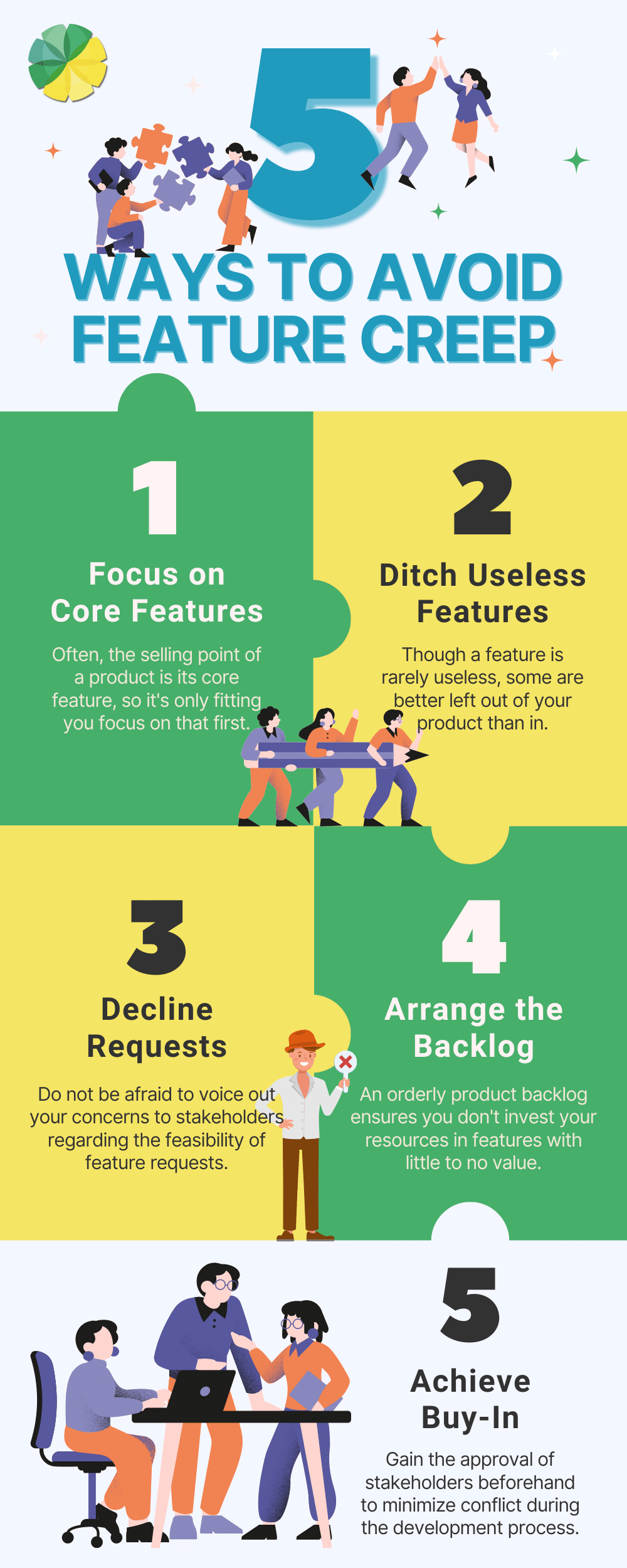
#1. Focus on the product’s core features
It helps to only focus on the product’s core features first.
You should proceed to the additional features and functionality only when they’re implemented. At this point, it’s much easier to tell if a feature would be helpful.
Consider the example of a gamified task management platform. Rather than going for the gamification elements immediately, it’s advisable to focus on its primary purpose first—to manage tasks. This means integrating task tracking and organisation before anything else.
Only after doing so should you incorporate gamification elements like badges, achievements, point systems, and other elements. Check out our cheatsheet to learn about these elements.
#2. Ditch features that offer little to no value
One of the challenges when avoiding feature creep is deciding which should remain and which should not. You can quickly solve this by tracking KPIs regarding product usage.
It should tell you which features are rarely used and which are often the cause of complaints from existing users. Simply ditch those features if you believe they add no value to users.
#3. Learn to say no
If ditching features seems like a waste of resources, you can instead just not add them in the first place. This tip, however, requires insight, among anything else, as well as initiative.
You, the product manager, will be the key to this particular tip.
Simply say no if you think the feature would offer little to no value if implemented. Whether it comes from your fellow team members or investors, you don’t always have to accept requests.
#4. List features according to importance
You must already have a product backlog as the product manager.
Aside from listing all the features requested by stakeholders, you must also arrange them according to importance. It would help to consult the development team in this regard.
With an ordered list, there’s a lower chance of adding features that will likely be useless.
After all, at that point, you likely would have already spent most of the project budget on developing core features. Keep in mind, though, that this would require user and market research to determine which features must be prioritised.
#5. Achieve buy-in throughout the company
Stakeholders like the executive management and investors can sometimes pressure the development team to add more features. As a result, you may deviate from the original plan.
To minimise this possibility, you should gain company-wide approval for focusing primarily on the core features. By doing so, you and the development team will have a reason to refuse feature requests from upper management. They did, after all, approve of your plan.
The bottom line: feature creep
Some features may seem pointless initially but become incredibly practical. Similarly, a particular feature may appear useful, but end up being impractical. Feature creep is when the latter case occurs repeatedly within a short period. It ultimately creates a product with little value to end users, among many other disadvantages feature creep can bring.
On the bright side, it’s possible to prevent feature creep. You would, however, need to understand what causes it in the first place, and this article should help in that regard.
If you intend to create a gamified software, an excellent alternative would be to have the features ready before development. Book a demo with Mambo now and see how that works.
Download your free
“Gamification Guide”
Get your PDF now and start transforming your approach to digital engagement!
Latest Posts
Machine Learning In Finance: 12 Essential Applications
The impact of machine learning on finance is significant. Thanks to this technology, financial institutions are now equipped to make efficient decisions. Through the analysis of data sets, machine learning […]
How To Create Interactive Compliance Training For Bank Employees
Banking compliance training isn’t just another task. It’s the stage where everything else performs. Banks must navigate a myriad of regulations and laws. After all, this is a trust-driven, high-stakes […]
How Fintech Apps Are Using Gamification To Increase User Engagement
Discover how gamification in fintech is revolutionizing financial engagement, making banking fun & boosting user loyalty.





